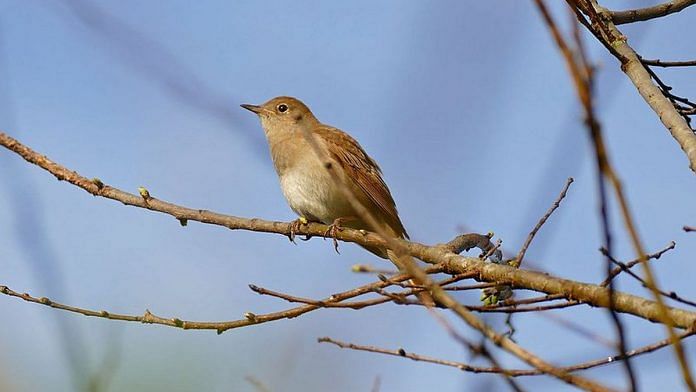New Delhi: Climate change has been increasingly endangering the Common Nightingale because its wings are getting shorter, found a new study conducted by a group of Spanish researchers.
Shorter wings will, over time, make this songbird less likely to survive its annual migration.
The Common Nightingale, known across the world for its beautiful song, breeds in Europe and parts of Asia. Every winter, these birds migrate to sub-Saharan Africa.
A study published in The Auk: Ornithological Advances has found that natural selection driven by climate change is causing the birds to evolve with shorter wings in the past two decades.
Researchers from the Complutense University in Madrid have analysed 20 years of data on wing shape variations and survival in two populations of nightingales from central Spain.
The data showed that the average wing length of nightingales has decreased in the past two decades. The bird’s wings are becoming less optimal for migration since shorter-winged birds are less likely to return to their breeding grounds after their first trip to Africa.
“There is much evidence that climate change is having an effect on migratory birds, changing their arrival and laying dates and their physical features over the last few decades,” Carolina Remacha, lead author of the study, said in a statement.
Also read: Marine species relocating to poles & possible ancestor of all animals found in Australia
‘Maladaptation’ making wings shorter
Scientists believe that a “migratory gene package” controls a set of intelinked genes which selectively favours some traits over others. This gene package takes care of a suite of adaptations that are necessary for migration — including a long wingspan, high resting metabolic rate, and shorter lifespan.
In the recent decades, the timing of spring has shifted in central Spain and summer droughts have become longer and more intense, leaving nightingales with a shorter window in which to raise their young.
This means that the most successful birds may be those that lay smaller clutches of eggs, giving them fewer young ones to care for. If natural selection favors smaller clutches, other linked traits in the “migratory gene package” may lose out.
In the case of nightingales, natural selection has been favouring a smaller clutch of eggs and this means the gene trait that enable the birds to have longer wings is getting suppressed.
Researchers have said that this is an example of “maladaptation”, where responses of organisms to changing climatic conditions end up being harmful instead of becoming helpful to them.
“If we are to fully understand how bird populations adapt to new environments in order to help them tackle the challenges of a rapidly changing world, it is important to call attention to the potential problems of maladaptive change,” said Remacha.
Also read: Coronavirus should finally make us act on illegal wildlife trade



